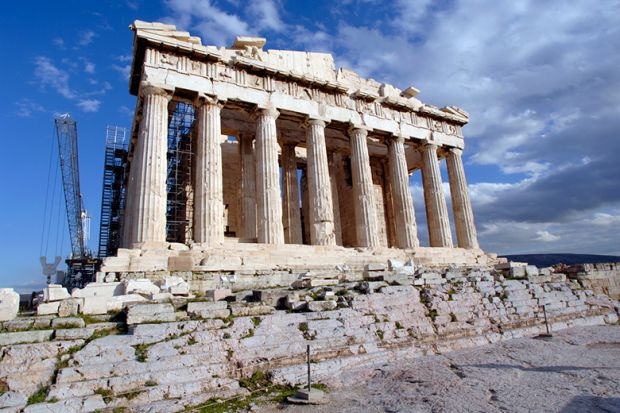Johanna Hanink’s The Classical Debt asks why the debt of Greece to the “troika” – the European Union, the European Central Bank and the International Monetary Fund – became a flashpoint in European politics after the financial crash of 2007.
She argues for a symbolic reading of the Greek debt in the light of Western constructions of “Greekness”. She quotes the view of Constantine Karamanlis (1907‑98), who served more than once as prime minister and as president of Greece, that characterised Europe as “a synthesis to which the Greek spirit introduced the idea of freedom, truth, and beauty…” In Hanink’s reading, this intellectual debt of modern Europe to “ancient Greece” led to an anxiety of influence that manifested itself in the punitive insistence that a monetary debt be repaid. Throughout, she treads the fault line between these two meanings, cultural and financial, of the Classical “debt”.
Although ambitious in scope (covering events from the 5th century BC up to the UK’s Brexit vote last year) and impressively researched, the book never quite lives up to its promise. Ultimately, readers may be left feeling a little short-changed. One instance is the Elgin Marbles debate, which bookends Hanink’s argument.
The Marbles, she writes, “remain potent, storied symbols and tangible evidence of the success of at least one of Britain’s former colonisation efforts: the metaphorical colonisation of Greek antiquity”. This is (apparently) a colonisation of the mind, in itself a somewhat nebulous notion. Yet it is surely oversimplifying to link the Elgin Marbles in any straightforward way with British imperialism. It is worth noting, for instance, that the 2016 bid for their return was thrown out by no less a body than the European Court of Human Rights.
One notable omission is a chapter on Rome. Hanink leaps straight from the self-fashioning of Classical Athens to the 18th-century Grand Tourists. Yet it was the Romans who created Greece as an ambivalent cultural paradigm. In the 1st century BC, Horace, Cicero and Virgil lauded the cultural achievements of the Greeks, in contrast with the pragmatic Romans, while historians such as Sallust implied that the Roman conquest of Greece was among the factors that led to the decline of the Roman Republic under the combined influence of foreign ideas and the spoils of empire.
As an afterthought, the book shifts from exploration to prescription. The epilogue offers a three-part revisionist educational programme. First, we should recognise the role of Athenian propaganda in constructing our idea of Athenian achievement. Second, we should encourage students to recognise in the “Greek miracle” a myth of Western origins. Third (slightly bafflingly), we should “encourage students to consider alternative views of and approaches to heritage management”. Perhaps this closing section is an attempt to make the book’s essentially exploratory argument look relevant.
In fact, this is a book that deals predominantly in symbols. Hanink quotes the modern Greek scholar Vangelis Calotychos indicting his fellow countrymen over their propensity for “wielding a symbolic narrative over more pragmatic strategies”. This could also apply to the book, which, while meticulous and ambitious, cannot claim to deliver a new educational programme.
Emma Gee is lecturer in Latin and Classical studies at the University of St Andrews and author of Mapping the Afterlife: From Homer to Dante (to be published in 2018).
The Classical Debt: Greek Antiquity in an Era of Austerity
By Johanna Hanink
Harvard University Press, 352pp, £23.95
ISBN 9780674971547
Published 26 May 2017
后记
Print headline: So demanding and so indebted




